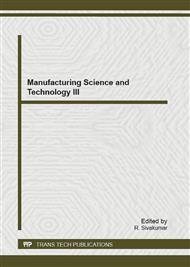[1]
Wade Trappe, Lawrence. c, Introduction to Cryptography with Coding Theory. Washington, Pearson Prentice Hall, (2002).
Google Scholar
[2]
I. Blake, G. Seroussi, N. Smart, Elliptic Curves in Cryptography, Cambridge University Press, New York, (1999).
Google Scholar
[3]
Adnan Gutub and Alexandre F. Tenca, Efficient Scalable VLSI Architecture for Montgomery Inversion in G (p), Integration, the VLSI Journal, Vol. 37, No. 2, pp.103-120, (2004).
DOI: 10.1016/j.vlsi.2003.12.001
Google Scholar
[4]
P. Kocher, J. Jaffe, B. Jun, Differential Power Analysis, Advances in Cryptology - Crypto 99 Proceedings, Lecture Notes In Computer Science Vol. 1666, Springer-Verlag, (1999).
DOI: 10.1007/3-540-48405-1_25
Google Scholar
[5]
D. Hankerson, A. Menezes, S. Vanstone, Guide to Elliptic Curve Cryptography, Springer-Verlag, (2004).
Google Scholar
[6]
G. Orlando, C. Paar, A scalable GF (p) elliptic curve processor architecture for programmable hardware, CHES '01 Proceedings of the Third International Workshop on Cryptographic Hardware and Embedded Systems, pp.348-363, (2001).
DOI: 10.1007/3-540-44709-1_29
Google Scholar
[7]
T. Kerins, E. M. Popovici, W. P. Marnane, An FPGA Implementation of a Flexible, Secure Elliptic Curve Cryptography Processor, International Workshop on Applied Reconfigurable Computing-ARC, pp.22-30, (2005).
Google Scholar
[8]
Mohammad Alkhatib, Azmi Jaafar, and Qacem Abu Al-Haija, Choices on Designing GF (p) Elliptic Curve Coprocessor Benefiting From Mapping Homogeneous Curves in Parallel Multiplications, International Journal on computer science and engineering, Vol. 3, No. 2, pp.467-480, (2011).
Google Scholar
[9]
Mohammad khatib, Qacem, and Azmi Jaafar, Hardware Architecture & Designs for Projective Elliptic Curves Point Addition Operation using Variable Levels of Parallelism, International Review on Computers and Software, Vol. 6 N. 2, pp.237-243, (2011).
Google Scholar
[10]
Mohammad Al-khatib, Azmi Jaafar, Zuriati Ahmad Zukarnain, and Mohamad Rushdan Md Said, Hardware Designs and Architectures for Projective Montgomery ECC over GF (p) Benefiting From Mapping Elliptic Curve Computations to Different Degrees of Parallelism, International Review on Computers and Software, Vol. 6, N. 6, pp.1059-1070, (2011).
Google Scholar
[11]
Adnan Abdul-Aziz Gutub and Mohammad K. Ibrahim, in: High Radix Parallel Architecture For GF(p) Elliptic Curve Processor, IEEE Conference on Acoustics, Speech, and Signal Processing, ICASSP 2003, Hong Kong, April 6-10, (2003).
DOI: 10.1109/icassp.2003.1202444
Google Scholar
[12]
Coron, J. -S, Resistance Against Differential Power Analysis for Elliptic Curve Cryptosystems, in: Cryptographic Hardware and Embedded Systems -CHES '99, (1999).
DOI: 10.1007/3-540-48059-5_25
Google Scholar
[13]
A. Gutub, M. Ibrahim, T. Al-Somani, Parallelizing GF (P) Elliptic Curve Cryptography Computations for Security and Speed, 9th International Symposium on Signal Processing and its Applications, pp.1-4, (2007).
DOI: 10.1109/isspa.2007.4555449
Google Scholar
[14]
C. McIvor, M. McLoone, J. McCanny, An FPGA Elliptic Curve cryptographic accelerator over GF (p), Irish Signals and Systems Conference, pp.589-594, (2004).
DOI: 10.1049/cp:20040606
Google Scholar
[15]
You-Bo Wang, Xiang-Jun Dong, Zhi-Guang Tian, FPGA Based Design of Elliptic Curve Cryptography Coprocessor, ICNC '07 Proceedings of the Third International Conference on Natural Computation, Vol. 5, pp.185-189, (2007).
DOI: 10.1109/icnc.2007.391
Google Scholar
[16]
U. Kocabas, J. Fan, I. Verbauwhede, Implementation of Binary Edwards Curves for Very-Constrained Devices, 21st IEEE International Conference on Application-specic Systems Architectures and Processors, pp.185-191, (2010).
DOI: 10.1109/asap.2010.5541003
Google Scholar


